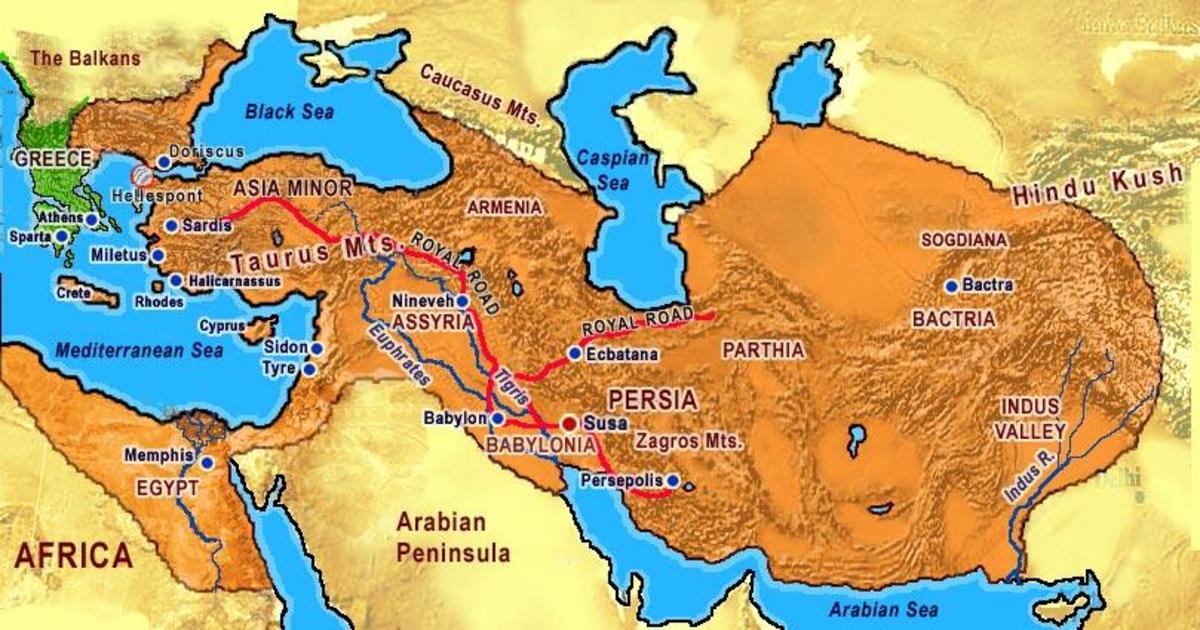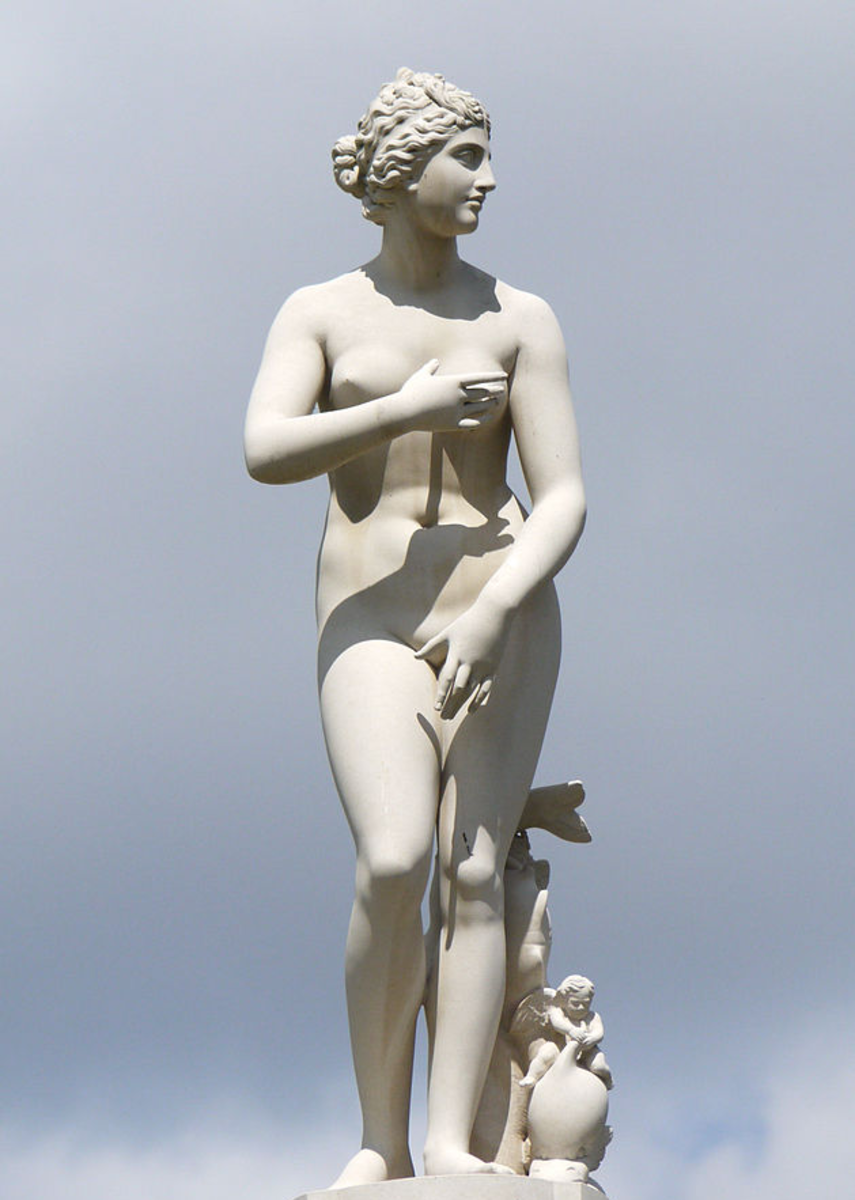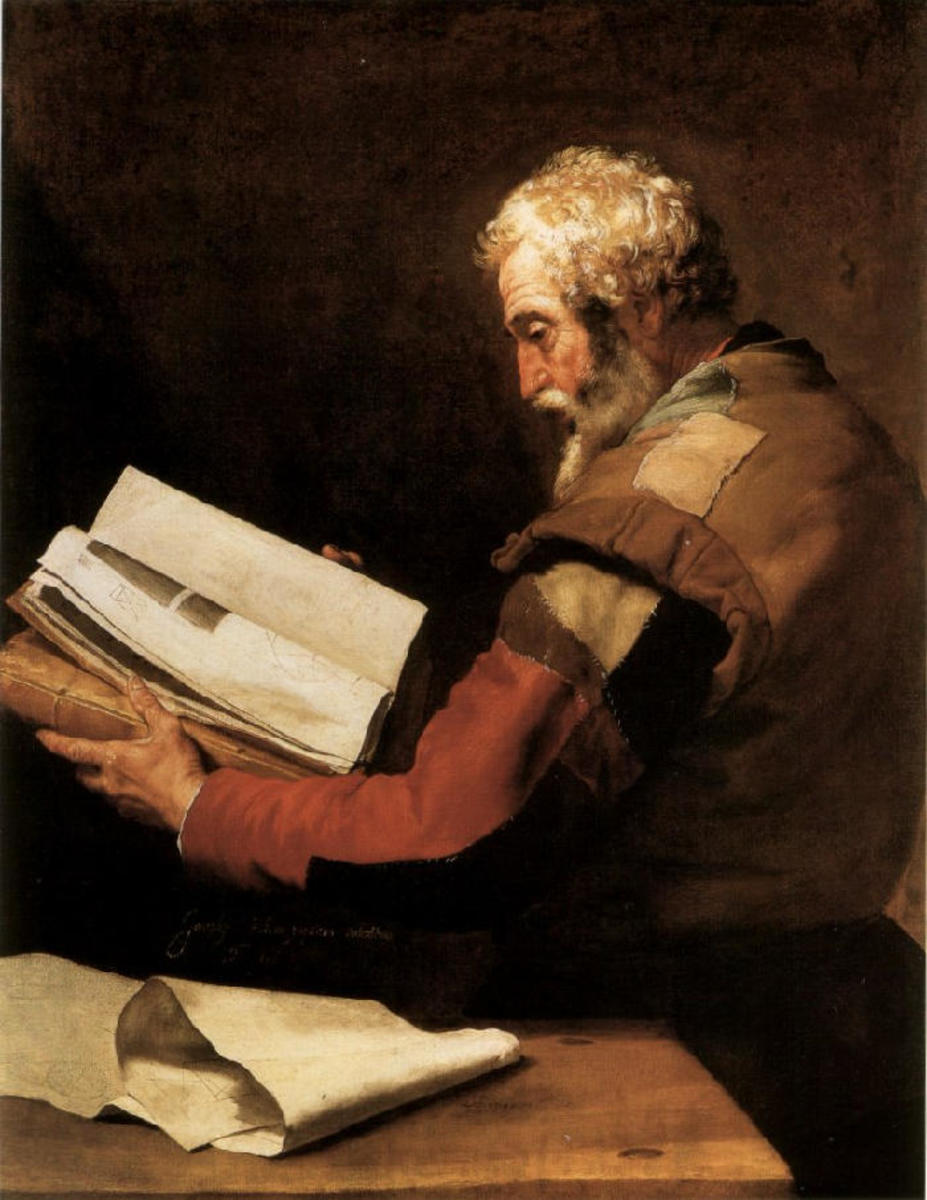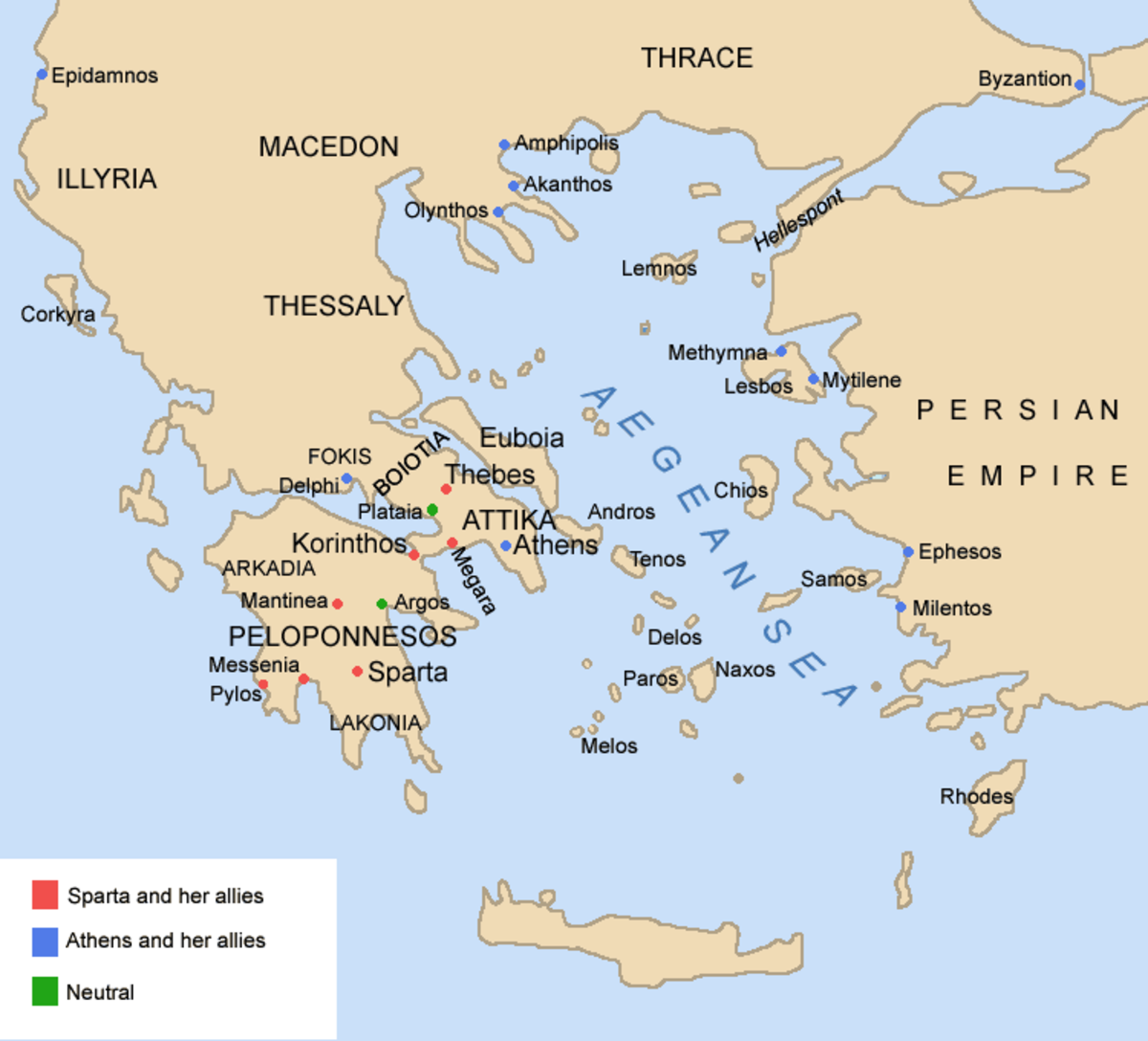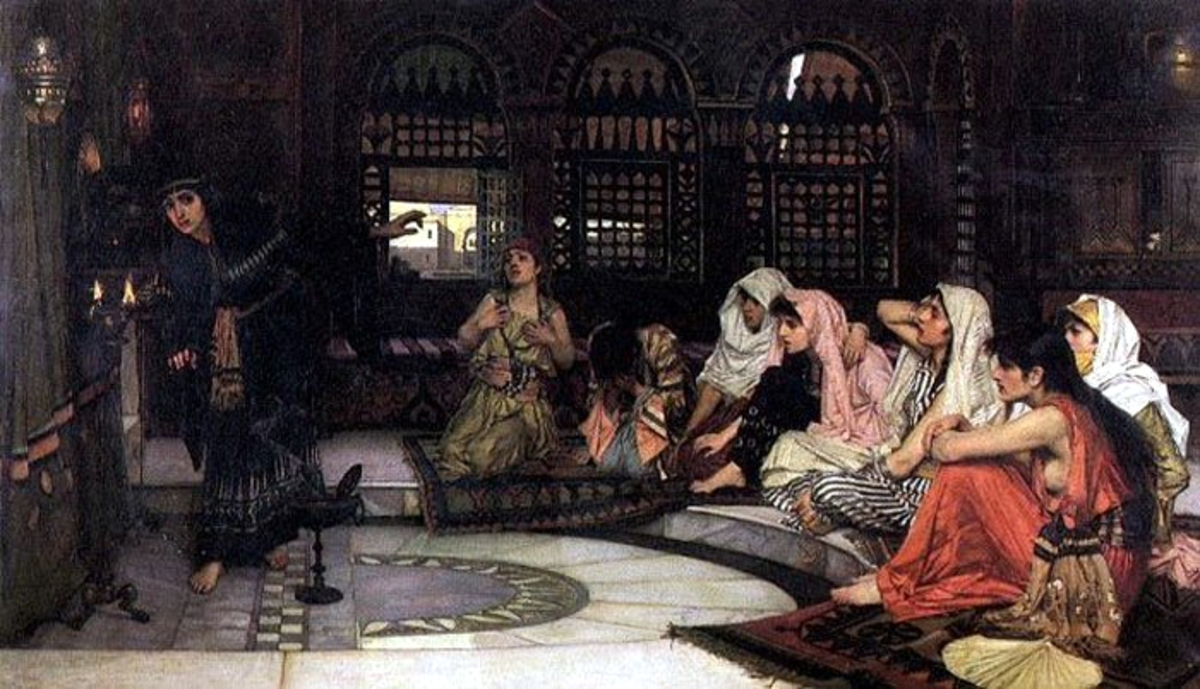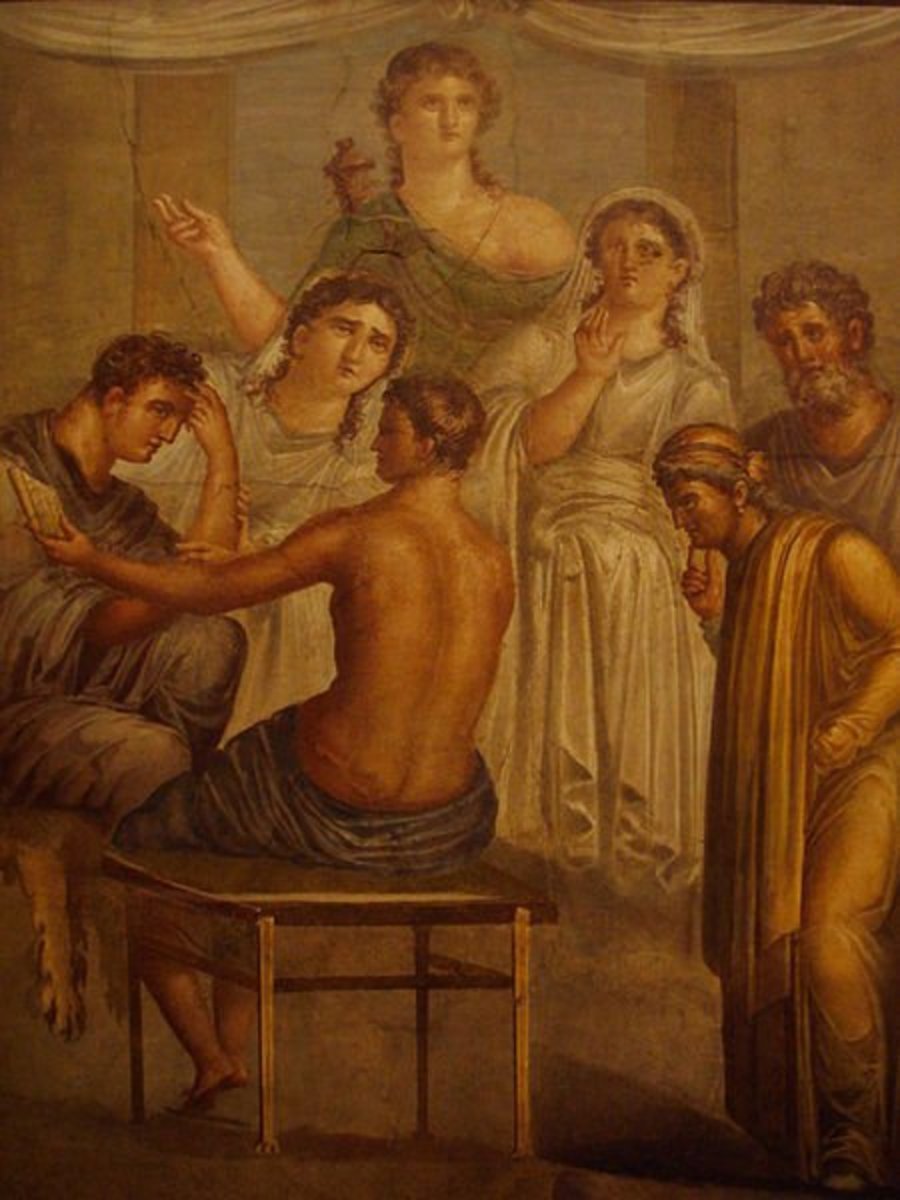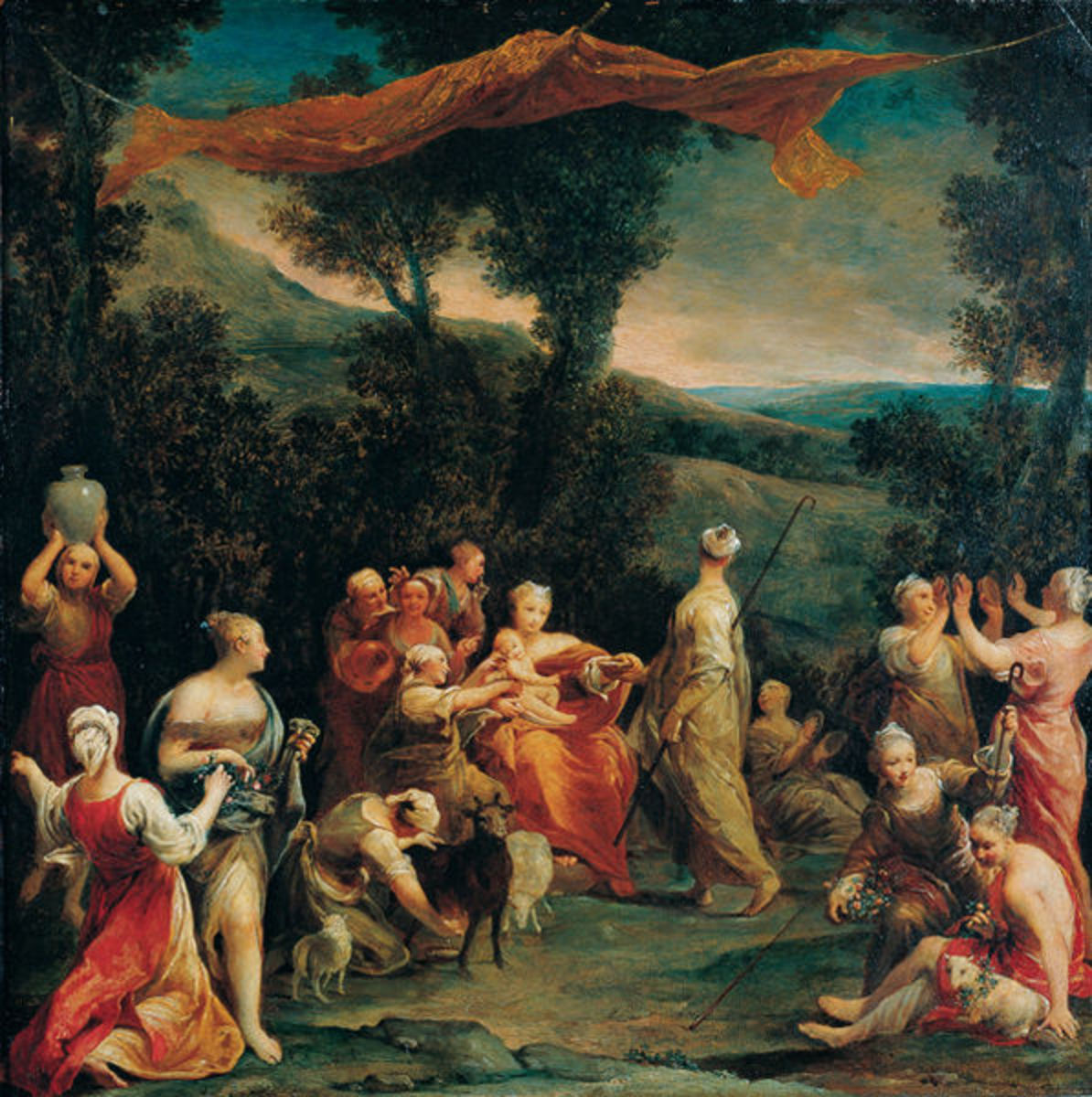- HubPages»
- Education and Science»
- History & Archaeology»
- Ancient History»
- Greek & Roman History
Athens: The Age of Pericles
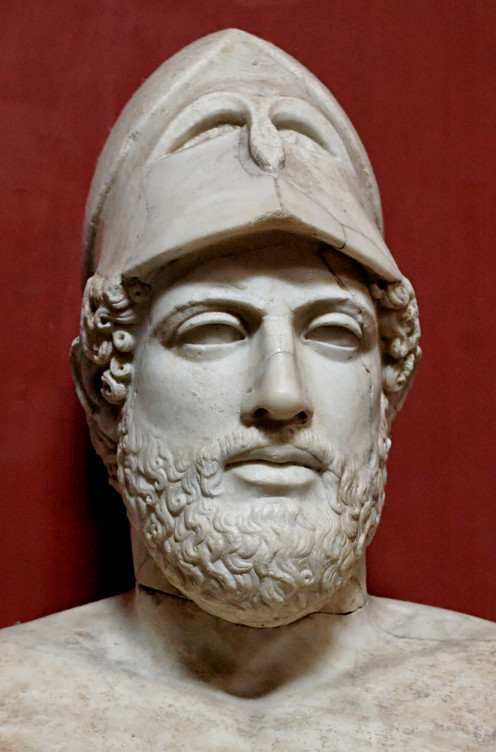
Rebuild Athens
During the Second Persian War, Xerxes I, King of Persia, had Athens burned to the ground in retaliation for Athens's support of the rebels during the Ionian Revolt. (For more see http://anitajsmith.hubpages.com/hub/The-Persian-Wars) The rebuilding of Athens started slowly in 478 BCE, just after the war with Persia, but when the general/politician Pericles obtained a position of authority in Athenian government in 461 and started a massive project of recreating the public places, Athens rose to the position of the most dominant city-state Greece.
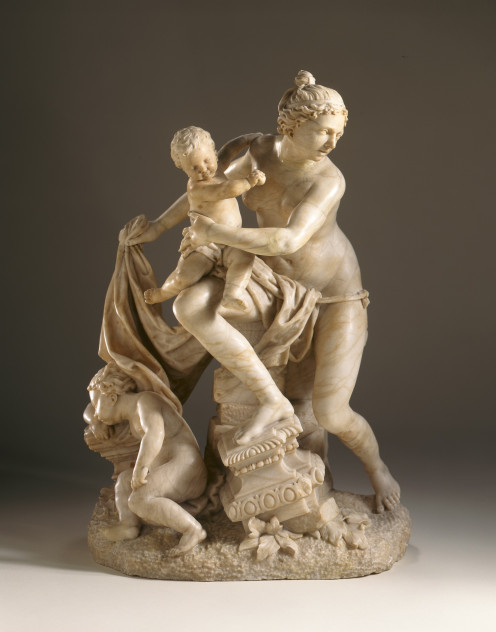
Financing the Rebuild
The project was extremely expensive, and Athens was not known for having a large number of wealthy citizens, but those it did count among its numbers were happy to provide what their city needed to become greater than it was before. Athens also had the benefit of a little thing called the treasury of the Delian League.
Following the Persian Wars, Athens and many of the other Greek city-states, with the exception of Sparta who wanted nothing to do with an Athenian led coalition, entered into an agreement to provide protection for one another. The Delian League, as the alliance was named, met and maintained a treasury (financial proceeds) on the island of Delos. Delos was considered a sacred place because of its connection to the birth of the twin gods Artemis and Apollo. In 478 BCE, Pericles, a political leader in Athens, brought the league treasury to Athens claiming it was not safe on Delos. He then proceeded to use some of those funds to rebuild Athens making it better than it had ever been before.
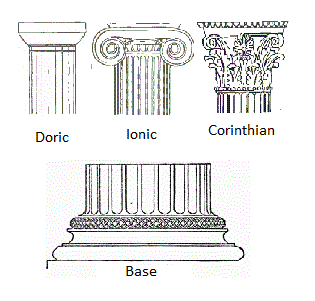
Building Projects
Pericles believed that just as Athens had been a model for government, with the creation of democracy, it should also be a model for all aspects of culture. His building projects only included public spaces, but he instituted a system of payment for those who worked on these projects. This allowed the city to hire the best engineers, builders and artists of the time.
No discussion of Greek architecture can begin without a look at the columns used in many of the building projects. Doric columns had no base and a simple square top. The Doric is also tapered to be smaller at the top and larger at the bottom. Ionic columns have a base at the bottom and scrolls at the top. The ionic column was usually smaller in diameter. Corinthian columns were the most decorative at the top. The tops had detailed carvings while the bottom had a base similar to the ionic column.
The most important building projects undertaken were the temples to the gods on the acropolis, a raised area above a city, with the centerpiece being the Parthenon, the temple to the goddess Athena for whom the city was named. Other buildings included those for government; the agora, a gathering place for commerce, athletics and religious functions; and the theater.
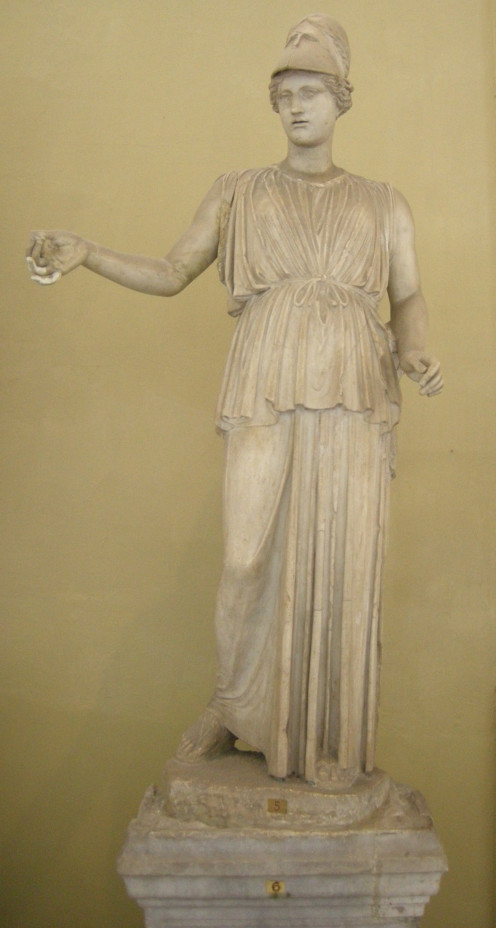
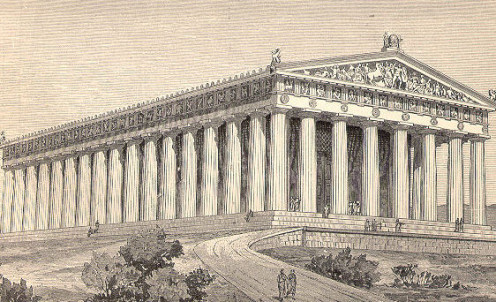
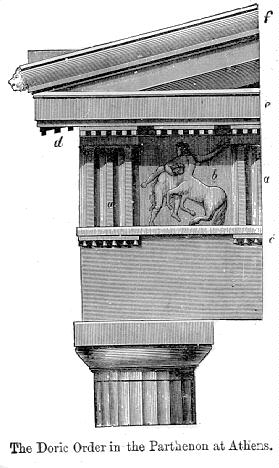
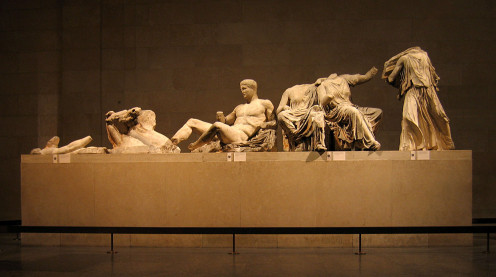
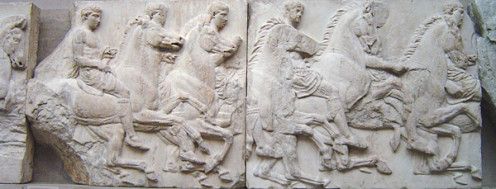
The Parthenon
Athena the goddess of wisdom and warfare, the daughter of Zeus and the Titaness Metis, entered into a contest with the sea god Poseidon for the right to be patron of the city formed along the Aegean Sea. Poseidon used his trident to strike the ground. At that spot, a saltwater spring appeared representing the cities superiority in the seas. Athena, not to be out done, caused an olive tree to grow. The city accepted the tree because it gave them not only olives as food, but also provided a source of oil and wood. The city was named Athens and the goddess was named patron.
The Parthenon was built to replace a pervious "Parthenon" that had been started during the First Persian War but destroyed when the Persians burned Athens during the Second Persian War. Each erected to honor the city's patron, Athena. The word parthenon means home of the maiden, which is fitting as Athena was one of the maiden goddesses. Though built as a temple, it did not include an alter or have priestesses, and no sacrifices or cult practices were carried out there. In this instance, the temple does truly seem to have been built as a home for the goddess.
Parthenon Architecture
The Parthenon platform is three layers of stone that appear stepped around the entire outer edge. The Doric columns were placed on the top of these three layers. There are eight columns across the ends and seventeen columns along each side.
Across the top of each end, there is a triangular shaped pediment, or gable. Within the pediments, Phidias created sculpted scenes from Greek religion. The east pediment showed the birth of Athena from her father Zeus's head. See http://anitajsmith.hubpages.com/hub/Father-of-the-Gods-Zeus for full story. The west pediment sculpture depicts the contest between Athena and Poseidon for patron of Athens.
Along the outer walls runs a frieze, decorative band, created by a sculptor named Kalamis. The east frieze depicted the battle between the Olympians and Gaea's fourth set of children, the Giants. This battle was called the Gigantomachy. The south frieze showed the battle of the Lapiths, from Thessaly, against the Centaurs, a wild breed of half-man/half-horse. This battle was called the Centauromachy. The western end showed the Amazonomachy, or the battle of the people of Athens against the Amazons, and the northern frieze depicted the Greeks defeating Troy in the Trojan War.
Today, many of these sculpted pieced can be found at the British Museum. They are called the Elgin Marbles.
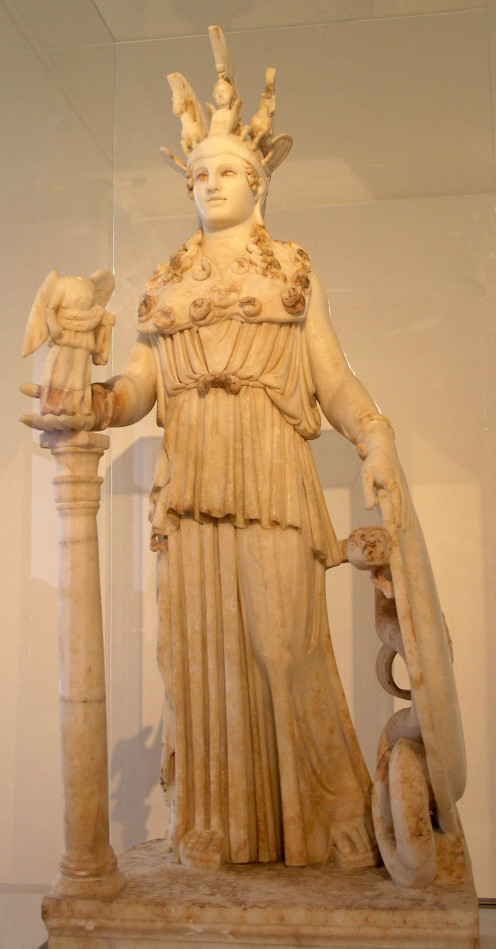
Athena Parthenos
Within the Parthenon, stood a massive statue of the goddess. Pericles commissioned the sculptor Phidias to create the statue. The height of the statue is not known for certain, but many scholars believe it was about 40 feet tall. Phidias started with a wooden frame that was covered with bronze. The areas representing the flesh of Athena was then covered in ivory while the remainder was covered in sheets of gold. While it is believed that Pericles used the treasury of the Delian League to pay for the construction and statuary of the Parthenon, the gold of the Athena Parthenos could have easily been removed during time of need. In this way, the statue itself served as a type of bank for the league.
The Athena Parthenos included not just the goddess, but also her shield and spear, though in many copies of the statue, the spear is not included. The goddess of victory, Nike, stands in Athena's right hand while she holds her shield in her left. Like the shield Athena presented to her father, Zeus, the breastplate of the goddess bares the face of Medusa. Protected between the shield and Athena is a large snake. The snake represents her adopted son, Erichthonious, the forth king of Athens.
The mythology of Erichthonious is that Athena once went to Hephaestus, the blacksmith god, to request weapons. Hephaestus fell immediately in love with the virgin goddess. Athena fled, but the god went after her and trapped her. With Hephaestus being lame, Athena got away, but not before Hephaestus had spilled his semen on her leg. Athena swiped the fluid onto the ground in disgust. The ground, being the earth goddess Gaea, brought forth a child, Erichthonious. Athena, wanting to raise a child, hid the boy and raised him. At one point in the story, Athena placed the baby into a box and gave him to the daughters of Cecrops, the first king of Athens, for safekeeping but warned then not to open the box. Of course, one of the sisters opened the box any. The myth varies a little as to what the sisters saw inside the box, but it always includes the baby and a snake. Erichthonious was often associated with a snake from that point forward.
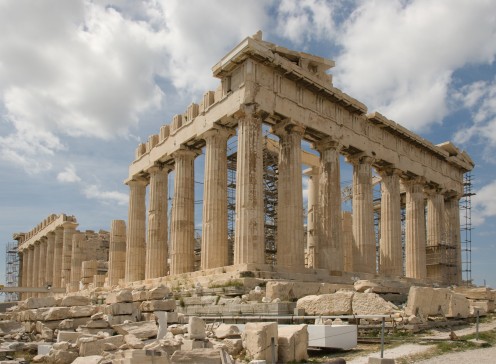
Parthenon Today
Today the Parthenon is in ruin. The roof and some of the interior were destroyed by fire in the third century CE. In 435 CE, Roman Emperor Theodosius II closed all pagan temples including the Parthenon. During the fifth century the Athena Parthenos was taken to Constantinople, the eastern capital of the Roman Empire. In the sixth century, the building was turned into a Christian church, The Church of the Parthenos Maria, or Virgin Mary. At least it was still a virgin. After the Ottoman Turks conquered Athens in 1456, the Parthenon was eventually turned into an Islamic mosque. During a Venetian attack in 1687, the Ottoman Turks were using the Parthenon to story gunpowder. A Venetian mortar round hit the gunpowder causing an explosion. The building suffered looting for the remaining time it was under Ottoman control including the Earl of Elgin entering an agreement with the Ottoman Sultan taking much of the remaining marble sculptures. The Greek government started a restoration project in 1975. The process has been very long and very expensive even with the financial help of the European Union.
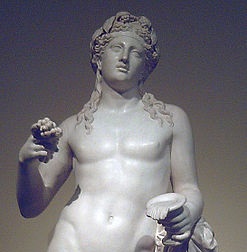
Theater of Dionysus
The god Dionysus, best known as the god of wine and madness, was also the god of theater. During the time of Pericles, the Theater of Dionysus Eleuthereus was built in Athens. Theater was very important to the Athenians. Not only where productions considered a type of religious festivity to honor the god, but also contests between the playwrights and actors.
Cut into the south side of the Acropolis, the Theater of Dionysus served many functions. It held festivals for the god and served as a meeting place for the entire democratic assembly.
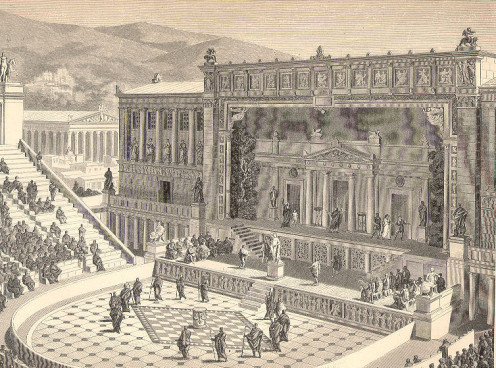
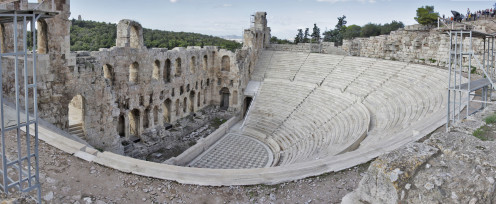
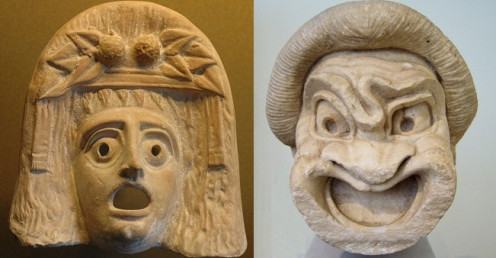
While not the Theater of Dionysus, the Athenian theater to the right provides a good example of a Greek theater. The theater was bowl shaped which provided perfect acoustics. It is said that an actor or orator, political speaker, whispering on stage could be heard by the citizens sitting in the last row. The Theater of Dionysus sat an estimated fourteen thousand citizens. The seating, while I'm sure not very comfortable, was durable as they were made from stone. At ground level, was a paved circle called the orchestra. Unlike a modern day orchestra made up of musicians, a Greek orchestra was a place for the chorus to perform, usually singing and dancing. These dozen or so cast members would sing or cite poems to explain any action taking place before, after, or off stage, so the audience would understand the story. A wall stood at the back of the stage and could be dressed up to represent the scene for the play. The wall also provided a "backstage" for costume changes and death scenes, as it was not acceptable to actually present a death on stage. Women were not allowed to perform, therefore, the female roles were also performed by men. To accomplish this, the actors wore masks, and because of the vast seating, the masked were designed to express the emotion of the scene in exaggeration.
There were three basic types of plays performed in the theater; tragedy, drama dealing with serious and dark themes that ended in some type of terrible event; comedy, humorous and light themes that had a happy ending; and satyr, plays using sexual situations and physical pranks to lighten the tension during a series of tragic plays. All three types usually told the stories of what we today call Greek mythology.
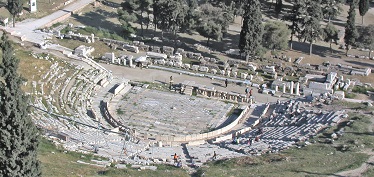
The Theater of Dionysus, like many other ancient Greek landmarks, had fallen into ruin over the thousands of years. Like other Athenian cites, Greece has begun a partial restoration project for the theater of the god of drama.
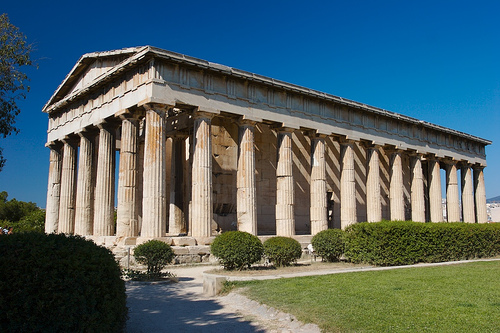
The Agora
The Agora in Athens was similar to the city-center of a modern city. Situated around a large open space, it included government buildings for all of the daily needs of the citizens, a courthouse to settle legal or criminal issues, and the main market place of the city. The Agora also had several temples to Olympian gods other than Athena. These temples include the Temple of Hephaestus.
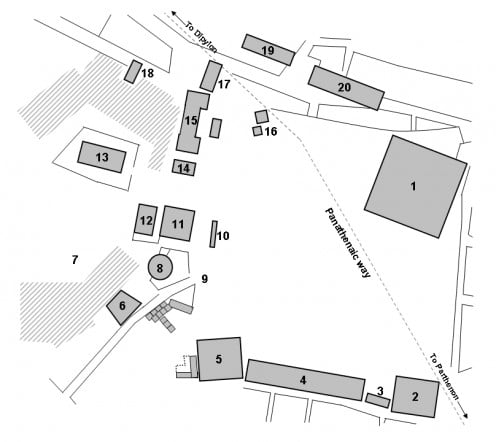
Greek Philosophy
Another area of Athenian cultural advancement was in philosophy. Philosophy is a course of study into such things as our own existence, right from wrong, how we think, and why we think that way.
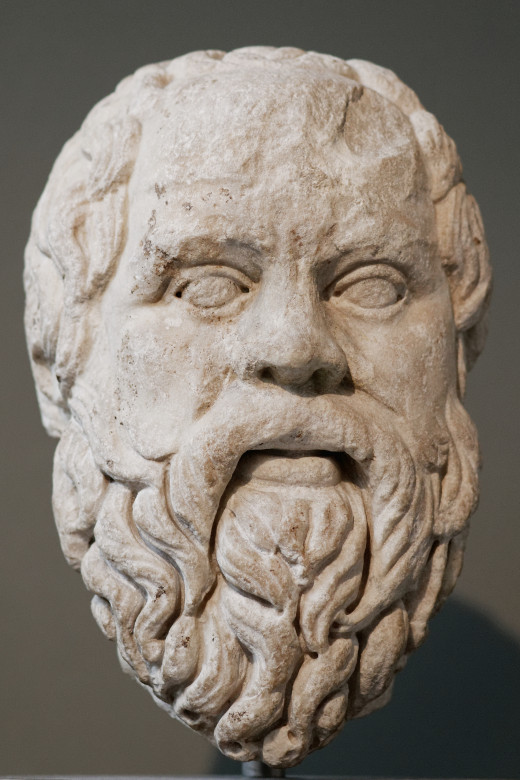
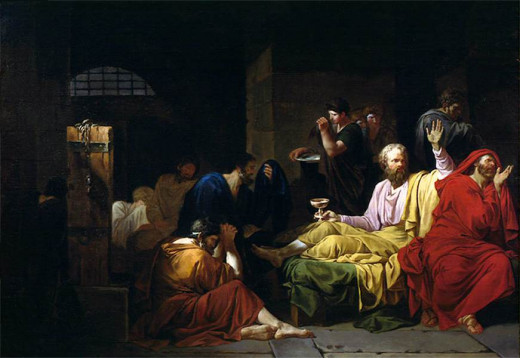
Socrates
Athens was the birthplace of one of the undisputed founders of philosophy, as we know it today. Socrates spent most of his adulthood working as a stonemason. He was married with three sons and by all accounts, lived a fairly normal life. In retirement, however, Socrates devoted himself to philosophical thinking.
Today we think of Socrates as being one of the greatest thinkers of all times, but in his own time, he was considered dangerous simply for asking the question why. He also criticized the changes he saw taking place in his own city in a time when criticism was deadly. Much of what we know about Socrates comes from his own student, Plato, as Socrates wrote nothing down. The story of Socrates fate is told to us in Plato's Apology.
It all started when a friend of Socrates visited the Oracle at Delphi and asked if there was anyone wiser than Socrates was. The Oracle told him there was not. Socrates did not understand this because he did not believe he was any smarter than the next person. He decided to test this by asking questions of those Athenian citizens most believe to be smart in order to prove the Oracle wrong. As he began to question the poets and government officials of the city, he started to realize that although they all thought they were pretty smart, they didn't know as much as they thought they did. Socrates then realized that having a good understanding of what you do not know, as he did, makes a man wiser than one who thinks they know it all. As he went about pointing this out to his fellow Athenians, he angered those same men he had used to prove his point. Unfortunately, for Socrates, Athens was a democracy and these men were in position of influence. Socrates was put on trial for corrupting the youth of the city by teaching them his ideas. He was found guilty, as those same men served as his jury. He was sentenced to death by drinking the poison hemlock. Though he had an opportunity to escape, he chose to face his death.
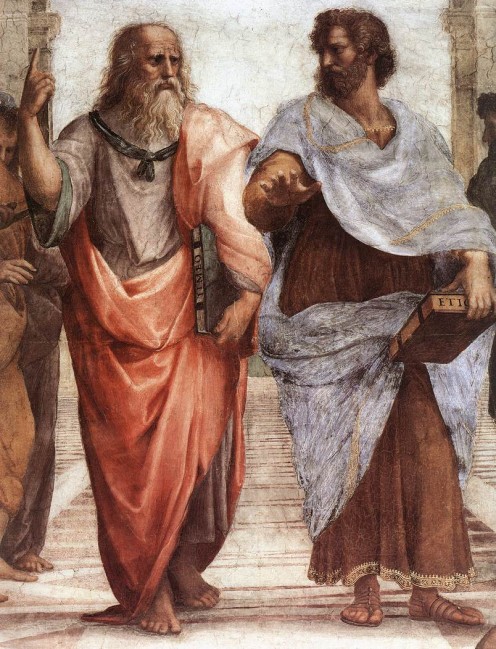
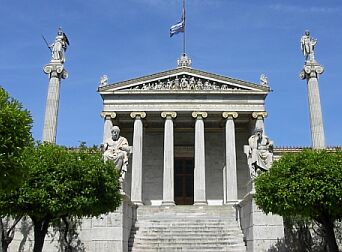
Plato
Plato was the son of an Athenian family of wealth and status. His father provided him with the best education available and in addition to philosophy, excelled at mathematics. Eventually, Plato became one of the youths Socrates was accused of corrupting when he became a student of the great philosopher. Plato was one of the few who attempted to prevent his teacher's death by offering to pay a fine to have the death sentence revoked. It is from Plato that we know the events of his teacher's life and work, as Socrates did not write down his own work.
After a time of travel through Italy and Northern Africa, Plato returned to Athens and began the first university called the Academy of Athens. The most famous student from the Academy was Aristotle, who would become the teacher of Alexander the Great.
Plato's best known work is The Republic. In his work, Plato explores the role of government and the meaning of justice through the actions of his mentor, Socrates. This writing is an example of the style Plato used for all of his writings. He wrote nothing as being his own thoughts or opinions, but generally giving Socrates credit for all of the ideas.
Unlike the death of his famed teacher, most accounts indicate that Plato died in his sleep at an old age.
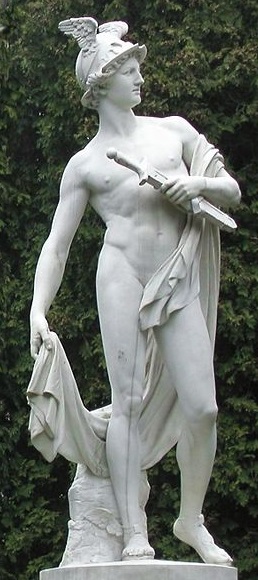
Athletics in Athens
Throughout Greece, athletics were an important part of life. Sporting competitions were held to honor the gods and the death of heroes. Athletics were so important, they were taught to every schoolboy along with reading, math and philosophy. In fact, the Olympics were considered so sacred that wars between city-states would be put on hold during the Olympics, so the best athletes could compete.
According to Greek mythology, many of the sports practiced by the citizens were invented by Hermes, the god of commerce, travel and athletics. Hermes, the son of Zeus, was the messenger of the gods because of his speed and athletic build. He was credited with creating several sports including wrestling and foot racing.
In Athens, the Panathenaic Games were held every four years as way to honor the goddess Athena. These games were second only the the Panhellenic Games, which included the Olympic Games every fourth year to honor her father Zeus. Like the Olympics, the Panathenaic Games included the sports of foot racing, wrestling, boxing, discus and javelin throwing and chariot racing. Unlike the Panhellenic Games, chariot racing was the most honored sport of the Panathenaic Games, as Athena was said to have created the chariot.
Greek Religion
The most important aspect of the life of the ancient Athenians was their religion. Sacrifices and prayers to the gods were given before not only major undertakings but also the events of daily life. While there are hundreds of Greek deities, the most important were the twelve Olympian gods.
.

Zeus was the King of Gods and father of many of the Olympians. He was responsible for freeing his brothers and sisters from the stomach of their father Kronos then leading them to defeat Kronos and his siblings, the Titans. He was the god of the sky and was responsible for the creation of humans.
Hera was the Queen of the Gods. She was the sister and wife of Zeus in addition to being the mother of Ares and Hephaestus. She was considered the most powerful of all the goddesses and was the goddess of marriage and motherhood.
Aphrodite was the goddess of love and beauty. She was the daughter of Uranus having been born from the sea foam after the father of Kronos was castrated by his son with his genitals falling into the ocean. She was the wife of Hephaestus although her affairs with other gods and mortals were legendary. Her greatest love was for Ares with whom she was the mother of Eros, better known by his Roman name of Cupid, and Phobos and Deimos, the gods of fear and terror, companions of their father Ares.
Demeter was the goddess of the harvest. She was the sister of Zeus and one of his five siblings freed from their father Kronos. She is best known for being the mother of Persephone who was fathered by Zeus. When her young daughter was kidnapped by another brother, Hades, Demeter refused to let plants grow until Persephone was returned.
Poseidon, was also a son of Kronos and Rhea and brother of Zeus. After he and the other gods defeated his father Kronos, Poseidon drew lots, drawing sticks to decide something, with his brothers Zeus and Hades and became the god of the seas.
Athena, the daughter of Zeus, was the goddess of wisdom and warfare. In addition to being very smart, a trait she inherited from her mother Metis, she was an expert in weaving and other domestic arts. As the patron of Athens, she was the most important of the Olympians to the people of Athens with the exception of her father Zeus.
Ares, the son of Zeus and Hera, was the god of war. He was cruel and bloodthirsty. He lived only for the brutality of war and his affairs with women, namely the goddess Aphrodite.
Hephaestus was the son of Hera, which she claimed to have conceived by consuming a lotus flower. This was out of spite for Zeus giving birth to Athena from his own head. Hephaestus was born lame and either Zeus or Hera threw him from Mount Olympus as an infant. He was the god of fire and forges and created most of the weapons of the Olympians.
Apollo, the twin brother of Artemis, was the son of Zeus. He was the god of the sun, archery, poetry and music. He was one of the most popular of the gods and played a role in many of the most important stories of the religion.
Artemis, the twin sister of Apollo, was the daughter of Zeus and the goddess of the moon and the hunt. Having helped their mother Leto give birth to her twin brother, she was also a goddess of childbirth. She was the protector of young girls and rivaled her twin as the best archer among the gods.
Hermes was another son of Zeus. He was the god of travelers, merchants, thieves, athletes and shepherds. He was the messenger of the gods and responsible for ensuring that the dead made their way to Hades. One of the most impressive stories of Hermes involves him stealing the cattle of his own brother Apollo on the day he was born and giving Apollo the lyre he had created for his forgiveness.
Dionysus was actually born a hero, child of a god and a mortal. After a life of troubles brought on by his stepmother, Hera, he was made a god by his father Zeus. He was the god of wine, having been credited with the creation of the drink, the god of madness and the god of drama.
Although she gave up her seat as one of the twelve Olympians to Dionysus in order to maintain peace within the family, Hestia, one of the six children of Kronos and Rhea, was the goddess of home and hearth. She was worshiped throughout every home in Greece.
The remaining child of Kronos and his sister/wife Rhea, though not allowed a seat on the Olympian Counsel, was Hades, the god of the Underworld. Though he was the oldest of Kronos's three sons, he drew the short stick when the brothers were drawing lots for control of the world and became the ruler of the dead. Out of the fear of death, most Greeks would not even speak his name
The Influence of Athens
The Athenians, although democratic, were in such a position of power and influence over the other city-states that it was considered and empire by some. Their influence did not stop with their fellow Greeks, however. Much of the culture of the Romans is directly linked to Athens including their gods, and while the founders of the United States practiced a different religion, their ideas on government started with the Athenians. Countries around the world remain captivated by the people of Athens copying their architecture, displaying statues of their gods, and sending athletes to the Olympic Games.







